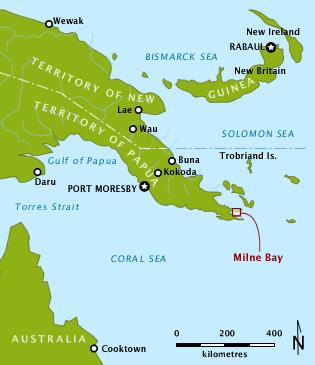
In 1942, the Imperial Japanese Navy saw considerable value in Milne Bay as a maritime and aviation base from which to attack northern Australia.
Milne Bay is noted for the ‘Turning Point’ battle, the title of Michael Veitch’s excellent book, which took place there in August–October 1942. A substantial Japanese naval force landed on the north shore of the bay only to be convincingly defeated.
Japanese survivors were evicted by the waiting Allied defenders comprising mostly Australian militia, Australian Imperial Force personnel and Australian fighter pilots, together with some American airfield engineers.
The bay became an important Allied naval and air force base.
HMAS Lavada and Gurney Airfield were of significant value in the Allied recovery of northern New Guinea and onward to the Philippines.
 Milne Bay is at the extreme south-eastern tip of Papua New Guinea. It’s been surveyed and charted by, among others, Bruni d’Entrecasteaux in 1791, Owen Stanley in 1850 and John Moresby in 1873. Milne Bay Province is one of three PNG provinces close to Australia that are underdeveloped (the other two are Western and Gulf provinces). Arguably, Milne Bay is the least developed.
Milne Bay is at the extreme south-eastern tip of Papua New Guinea. It’s been surveyed and charted by, among others, Bruni d’Entrecasteaux in 1791, Owen Stanley in 1850 and John Moresby in 1873. Milne Bay Province is one of three PNG provinces close to Australia that are underdeveloped (the other two are Western and Gulf provinces). Arguably, Milne Bay is the least developed.
Milne Bay is very hot, wet, muddy and rife with crocodiles and nasty tropical diseases. But it’s sheltered and mostly deep, with many indents and bays offering useful and safe anchorages. The bay is less than 500 nautical miles from Cairns—close to many of Australia’s important mineral and agricultural export ports and the shipping routes that serve them.
Milne Bay and its main town, Alotau, located near the head of the bay, are at the centre of an archipelagic province that incorporates around 600 disparate volcanic islands and atolls. On several of those, and the PNG mainland surrounding the bay, industries such as timber, mining, fishing, copra, cocoa, palm oil and tourism have been attempted. All have suffered from inadequate transport infrastructure; there are no roads or railways linking the bay with other parts of PNG. Expensive aviation and quite limited coastal cargo shipping provide the only links.
Given China’s wish to play a direct and growing security role in our near region and the fact that Australia’s defence strategic review is looking at where our military are best positioned to enable operations, now’s the time to initiate a joint Australia and PNG project to enhance the port facilities and airfield at Milne Bay.
The Australian defence benefits arising from such a project are obvious. A glance at an atlas shows why the bay attracted the attention of Japanese strategists more than 80 years ago. It offers better potential defensive coverage of the vital Solomon and Coral seas than Manus Island more than 500 nautical miles to the north (where the Lombrum Naval Base is being upgraded to accommodate PNG’s Guardian-class patrol boats) or Daru, in the shallow reef-strewn Torres Strait, where China is interested in developing maritime infrastructure.
Australian forces could operate from Milne Bay in support of PNG and other Pacific Islands Forum partners. The US military may be interested in leveraging enhanced infrastructure there as well.
The US will soon begin negotiations with PNG on a defence cooperation agreement. President Joe Biden’s administration is now emphasising that the South Pacific plays a critical role in helping preserve a free and open Indo-Pacific region.
The highly trafficked China Strait shipping channel, connecting the Solomon Sea with the Coral Sea, passes close to the entrance of Milne Bay.
Milne Bay offers considerable prospects for Australian and PNG government development co-operation. There’d be many economic and social benefits that would accrue to PNG in building a useful and strategically convenient multipurpose port facility and airport at minimal cost. It’s convenient for Australian civil engineering and coastal construction companies.
The town of Alotau is home to about 20,000 people and is the focal point for an overall provincial population of around 300,000. It boasts two main wharves and a barge launching ramp as well as the Gurney Airfield.
The bay’s maritime and aviation infrastructure could both be relatively quickly and inexpensively expanded to provide for landings and refuelling of significantly larger ships and aircraft. Some wharf development is currently underway, with Queensland-based firm Pacific Marine Group working on a new wharf there.
But to enhance the bay’s defence and economic usefulness, further wharf, container and liquid storage, and a large jet-capable airfield are needed.
While many local people have over the years expressed an aversion to economic and infrastructural development, they suffer very badly from the health problems that accompany a semi-subsistence lifestyle in the tropics.
The local communities may well be persuaded of the potential life-enhancing and economic benefits that limited development might bring. Any proposals would need to be promoted very carefully with community leaders. Landowner disputes have caused considerable delays to Australia’s upgrade of the base at Lombrum.